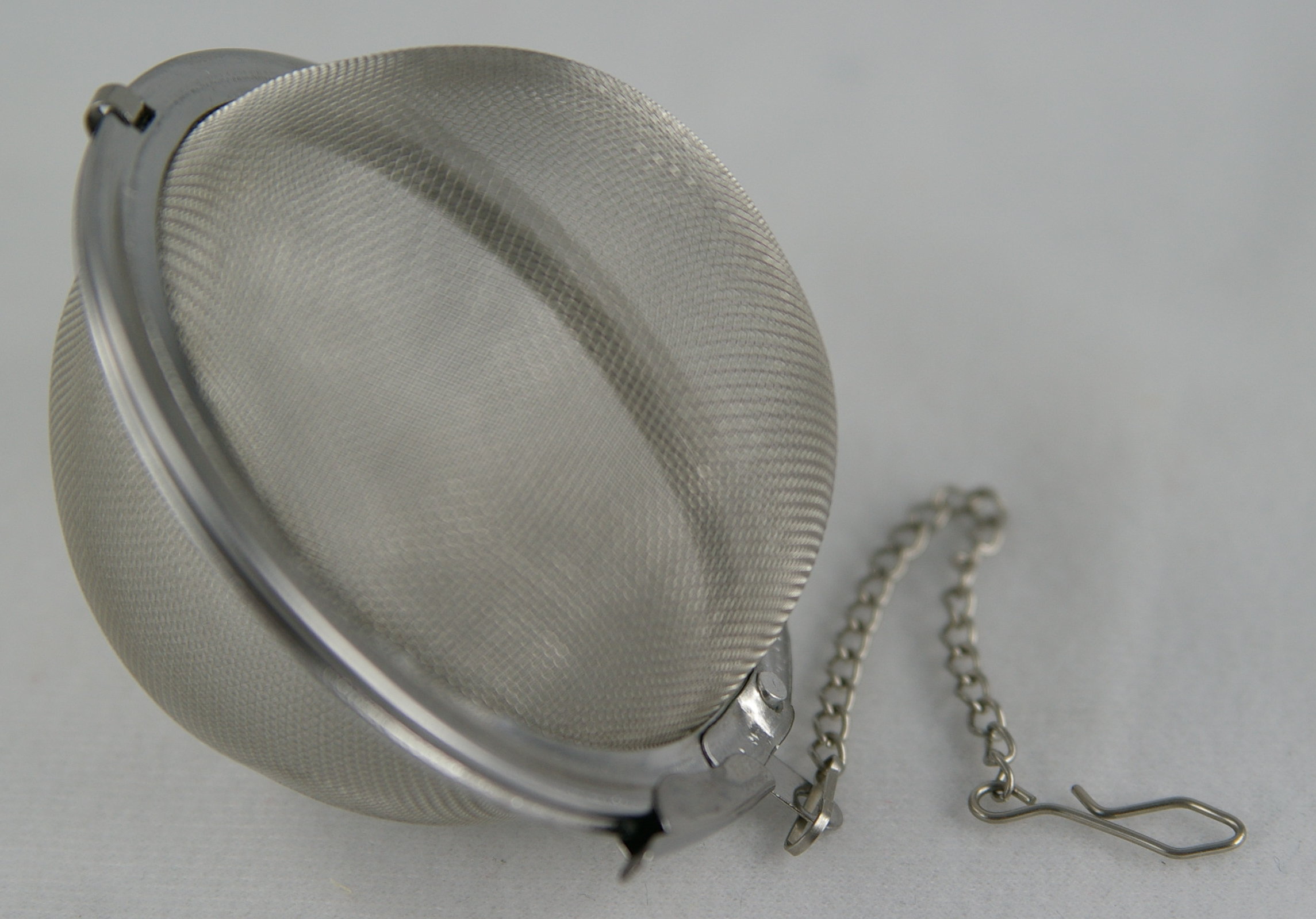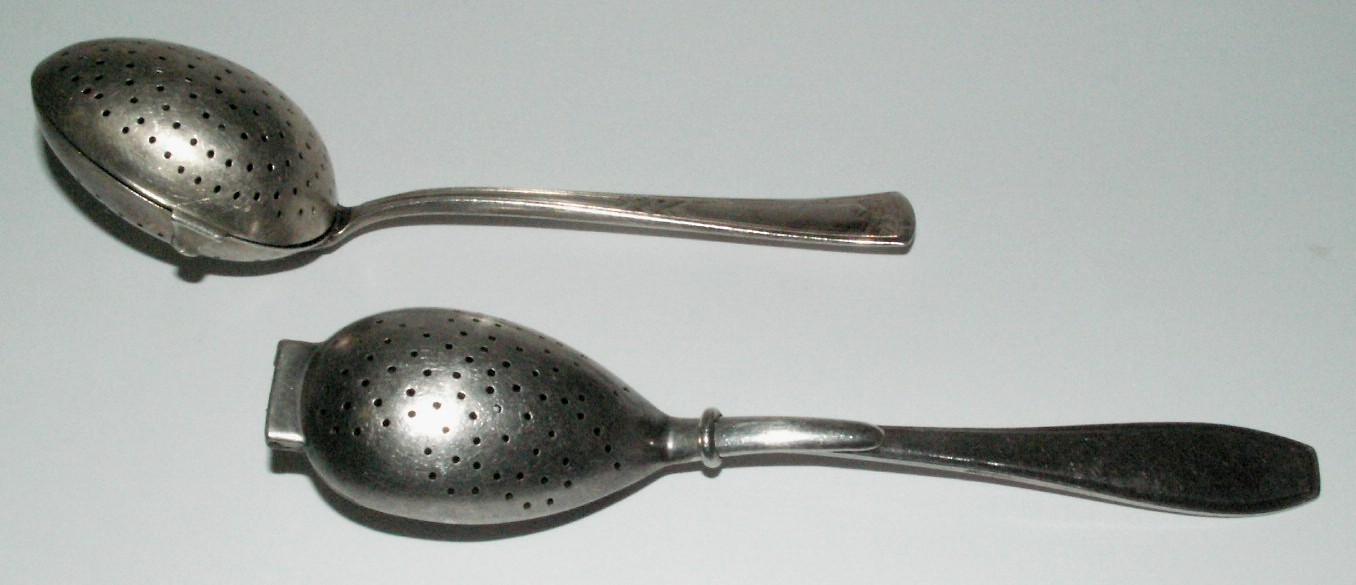Infuser on:
[Wikipedia]
[Google]
[Amazon]
A tea infuser is a device in which loose, dried tea leaves are placed for

 Ball infusers are removed along with the tea leaves from the pot.
Ball infusers are removed along with the tea leaves from the pot.
 Snap ball tea strainers are automatically sealed with the force of the end of the handle that is circulated like a spring. The spring handle requires more metal to manufacture, thus they are usually a bit more expensive than regular infuser balls.
The handle in snap ball tea strainers make them more practical:
* They can be used as a
Snap ball tea strainers are automatically sealed with the force of the end of the handle that is circulated like a spring. The spring handle requires more metal to manufacture, thus they are usually a bit more expensive than regular infuser balls.
The handle in snap ball tea strainers make them more practical:
* They can be used as a
steeping
Steeping is the soaking of an organic solid, such as leaves, in a liquid (usually water) to extract flavours or to soften it. The specific process of teas being prepared for drinking by leaving the leaves in heated water to release the flavour ...
or brewing, in a mug
A mug is a type of cup typically used for drinking hot drinks, such as coffee, hot chocolate, or tea. Mugs usually have handles and hold a larger amount of fluid than other types of cup. Typically, a mug holds approximately of liquid. A mug i ...
or a teapot
A teapot is a vessel used for steeping tea leaves or a herbal mix in boiling or near-boiling water, and for serving the resulting infusion which is called tea. It is one of the core components of teaware. Dry tea is available either in tea ba ...
full of hot water; it is often called a teaball or tea maker, and sometimes a tea egg. The tea infuser gained popularity in the first half of the 19th century. Tea infusers enable one to easily steep tea from fannings and broken leaf teas.
Use
A tea infuser performs a similar function as atea bag
A tea bag, or the compound teabag, is a small, porous, sealed bag or packet, typically containing tea leaves or the leaves of other herbs, which is immersed in water to steep and make an infusion. Originally used only for tea (''Camellia ...
, a later American invention. The infuser is generally a small mesh
A mesh is a barrier made of connected strands of metal, fiber, or other flexible or ductile materials. A mesh is similar to a web or a net in that it has many attached or woven strands.
Types
* A plastic mesh may be extruded, oriented, ex ...
or perforated metal container or covered spoon
A spoon is a utensil consisting of a shallow bowl (also known as a head), oval or round, at the end of a handle. A type of cutlery (sometimes called flatware in the United States), especially as part of a place setting, it is used primarily for ...
that holds tea leaves, in varying sizes to steep single or multiple servings at once. Common shapes for infusers include spherical, conical and cylindrical. One style of infuser is a split sphere with tong-like handles to open its mesh container.
The infuser is placed in a cup or pot of hot or boiling water, allowing the tea to brew without loose tea leaves spilling into the pot or cup. A rod or chain is commonly attached to the container of the infuser to simplify retrieval from the pot or cup. Infusers with large holes may not catch all the leaves, requiring the use of a tea strainer
A tea strainer is a type of strainer that is placed over or in a teacup to catch loose tea leaves.
When tea is brewed in the traditional manner in a teapot, the tea leaves are not contained in teabags; rather, they are freely suspended in ...
to remove the remaining pieces.
An infuser that produces more gravity than the buoyancy
Buoyancy (), or upthrust, is an upward force exerted by a fluid that opposes the weight of a partially or fully immersed object. In a column of fluid, pressure increases with depth as a result of the weight of the overlying fluid. Thus the pr ...
of floating material it carries will sink. And pressure increases with depth as a result of the weight of the overlying fluid. Thus, the pressure at the bottom of a tall container of fluid is greater than at the top of the container.
Alternative use
Quick water imbibition
Waterimbibition
Imbibition is a special type of diffusion that takes place when liquid is absorbed by solids-colloids causing an increase in volume. Water surface potential movement takes place along a concentration gradient; some dry materials absorb water. A ...
takes half the time for material that floats with half its area above the water surface when they are submerged with an infuser.
Seeds are often pre-treated before sowing in order to verify that they will sprout. Imbibition
Imbibition is a special type of diffusion that takes place when liquid is absorbed by solids-colloids causing an increase in volume. Water surface potential movement takes place along a concentration gradient; some dry materials absorb water. A ...
of water through the membrane of the seed shell is the first step in the germination
Germination is the process by which an organism grows from a seed or spore. The term is applied to the sprouting of a seedling from a seed of an angiosperm or gymnosperm, the growth of a sporeling from a spore, such as the spores of fungi, fer ...
process in most seeds. Seeds can be submerged with an infuser, including hot water scarification treatment for tolerant species. Seeds can be weighed with a milligram scale before and after they have been submerged to find out when they don't need to be exposed to more water imbibition. Floating seeds can be inspected when they have to sink inside mesh infusers submerged in transparent containers by shaking them. Seeds who don't absorb water will not germinate and must be modified with further scarification
Scarification involves scratching, etching, burning/ branding, or superficially cutting designs, pictures, or words into the skin as a permanent body modification or body art. The body modification can take roughly 6–12 months to heal. In the ...
.
Also, hot water treatment at 90 degrees C for 90 seconds followed by dip in cold water for 30 seconds can be an effective seed decontamination method against escherichia coli
''Escherichia coli'' (),Wells, J. C. (2000) Longman Pronunciation Dictionary. Harlow ngland Pearson Education Ltd. also known as ''E. coli'' (), is a Gram-negative, facultative anaerobic, rod-shaped, coliform bacterium of the genus '' Esc ...
O157:H7 and salmonella
''Salmonella'' is a genus of rod-shaped (bacillus) Gram-negative bacteria of the family Enterobacteriaceae. The two species of ''Salmonella'' are ''Salmonella enterica'' and ''Salmonella bongori''. ''S. enterica'' is the type species and is f ...
.
Types
Ball

 Ball infusers are removed along with the tea leaves from the pot.
Ball infusers are removed along with the tea leaves from the pot.
Snap ball
 Snap ball tea strainers are automatically sealed with the force of the end of the handle that is circulated like a spring. The spring handle requires more metal to manufacture, thus they are usually a bit more expensive than regular infuser balls.
The handle in snap ball tea strainers make them more practical:
* They can be used as a
Snap ball tea strainers are automatically sealed with the force of the end of the handle that is circulated like a spring. The spring handle requires more metal to manufacture, thus they are usually a bit more expensive than regular infuser balls.
The handle in snap ball tea strainers make them more practical:
* They can be used as a spoon
A spoon is a utensil consisting of a shallow bowl (also known as a head), oval or round, at the end of a handle. A type of cutlery (sometimes called flatware in the United States), especially as part of a place setting, it is used primarily for ...
to swirl solutions that will dissolve their content faster than tea infusers without a handle.
* Air inside a snap ball infuser can easily be eliminated by shaking the handle once it has been put into liquid, to make sure everything inside the ball becomes submerged.
Shut-off infusers
Shut-off infusers are left in the pot after the brewing process is complete.Alternatives
=French press
= While not common, aFrench press
A French press, also known as a cafetière, ''cafetière à piston'', ''caffettiera a stantuffo'', press pot, coffee press, or coffee plunger, is a coffee brewing device, although it can also be used for other tasks. In 1923 Ugo Paolini, an Ita ...
may be used as a tea infuser. However, most teas are infused only for a limited time and then removed from the water so that the drink does not become bitter.
In ''gōngfu chá'' (功夫茶), a modern method to infused tea in China, tea can be infused through a ''gàiwǎn'' (盖碗), a tea pot (茶壶) or a ''gōngdào bēi'' (公道杯).
See also
*Tea culture
Tea culture is defined by the way tea is made and consumed, by the way the people interact with tea, and by the aesthetics surrounding tea drinking.
Tea plays an important role in some countries. It is commonly consumed at social events, and ...
References
{{Teas Teaware